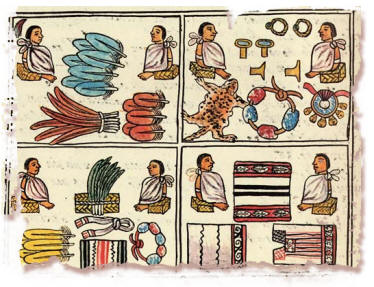During pre-Hispanic times, the territory which today comprises Mexico was a mosaic of many cultures, all very different from each other. These included not only the Mayan civilization in the Yucatan Peninsula and the Mexica in the Valley of Mexico, but also the Zapotec and Mixtec in the state ofOaxaca, the Totonac in Veracruz, the Tabasco Olmecs, the Toltecs in Hidalgo and the Purepecha in Michoacan …
Each culture had its own social structure, its own language, their own artistic expressions reflected in beautiful buildings, sculptures and crafts, as well as their own gods.
Moreover, each culture, being in a natural setting with different resources, found its own way of using them for food. The forests, jungles, and deserts offered different meats, fruit, seeds, roots, spices and even minerals that little by little revealed their delightful qualities to the ancient Mexicans, creating a culinary diversity that fortunately persists to this day.
However, the variety coincides in some respects, such as the trilogy of corn, beans and chile as a staple of the common man in all the pre-Hispanic cultures of Mexico. Likewise, they shared the belief of the sacred meal of corn, which was even represented by a deity.
All Pre-Hispanic cultures considered food, and specially maize, as an essential element of the offerings to their gods. A few grains of amaranth were placed in the mouth of the dead and after being incinerated, they were buried along with rich offerings of food.
When the Mexica of Tenochtitlan became an Empire that dominated all other cultures, they began to exact tribute from all the surrounding regions. That’s how this metropolis became the meeting point of different styles and ingredients, some so exotic that Western civilizations couldn’t even imagine.
The richness of colors, flavors and aromas acquired by Mexican cuisine can be imagined with the descriptions made by chroniclers of the Conquest, Hernan Cortes and Bernal Díaz del Castillo, referring to the cuisine ofTlatoani Montezuma, emperor of Tenochtitlan. Heriberto Garcia, author of Pre-Hispanic Mexican Cuisinesummarizes:
“Runners on foot, in relays, like ancient postmen and couriers, carried seafood to the emperor Moctezuma (…), who maintained up to three thousand men and women in his service. His tableware consisted of gold and silver glasses, gourds and jars. Daily, his chefs prepared up to300 different dishes for him to choose which they should serve him.(…) Every day they served the emperor turkey, pheasant, partridges, duck, deer, rabbit, birds and various fowl, fish and seafood, plus gourds of frothy chocolate that he drank with relish.”
Fray Bernardino de Sahagun, in his book History of the Things of New Spain, lists some of the dishes that were prepared in Mexica noble houses that are now the pride of the national recipe collection, such as pipian, turkey and fish sauces prepared with various chiles.
Color also defines Mexican cuisine.The first sense that seduces is precisely sight. Heriberto Garcia said: “One thing distinguished pre-Hispanic indigenous cuisine more than any other in the world: its presentation and good taste: the rich and varied color of its victuals and the taste emanating from them. (…)Perhaps no other people in the world, served so many varied dishes, prepared with more colorful flowers, as the ancient Mexicans. And when they had no natural color; annatto, prickly pear, chile, sapodilla and other vegetable dyes provided them coloring.”
With all this culinary richness, one could imagine that among the ancient Mexicans there was a propensity for obesity, but not so. Before the Spanish arrived, most of the inhabitants of Mexico were of medium height and had an athletic figure with taught brown skin over lean muscles. There was a great sense of moderation among them. Parents often instructed their children in this regard, as evidenced in the following speech related byFray Bernardino de Sahagun:
“Be advised, my son (…) do not eat too much in the morning and evening. Be temperate in eating lunch and at dinner, and if you work, you should have lunch before work begins. When you eat, eat slowly; do not eat with too much abandon, nor by using great mouthfuls, nor should you cram different food together in your mouth or swallow what you eat, like a dog. You shall eat at leisure and at rest, and drink with moderation …”
Long and delectable is the list of flavors that pre-Hispanic Mexico brought to the world. Exotic and spicy flavors with bright colors that invite you to taste them. While many recipes from those times are forgotten, practically all of the ingredients have survived.
Thus, we Mexicans have a living legacy from our ancestors, one that we share proudly with the world.


